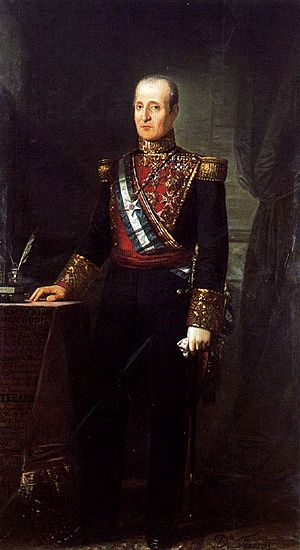José Ramón Rodil, 1st Marquess of Rodil facts for kids
Quick facts for kids
The Most Excellent
The Marquess of Rodil
|
|
|---|---|
 |
|
| Prime Minister of Spain | |
| In office June 17, 1842 – May 9, 1843 |
|
| Preceded by | Antonio González y González |
| Succeeded by | Joaquín María López |
| Minister of War of Spain | |
| In office April 27, 1836 – May 15, 1836 |
|
| Preceded by | Ildefonso Díez de Rivera |
| Succeeded by | Antonio Seoane |
| In office August 20, 1836 – November 26, 1836 |
|
| Preceded by | Andrés García Camba |
| Succeeded by | Javier Rodríguez |
| In office June 17, 1842 – May 9, 1843 |
|
| Preceded by | Evaristo Fernández de San Miguel |
| Succeeded by | Francisco Serrano |
| Personal details | |
| Born | February 5, 1789 Santa María de Trovo, Spain |
| Died | February 20, 1853 (aged 64) Madrid, Spain |
| Political party | Progressive Party |
| Alma mater | Mondoñedo Seminary University of Santiago de Compostela |
| Signature | |
| Military service | |
| Allegiance | |
| Rank | Captain general |
| Unit | Literary Battalion |
| Battles/wars | Spanish War of Independence
Spanish American wars of independence First Carlist War |
José Ramón Rodil y Campillo (born February 5, 1789, in Santa María de Trobo, Spain – died February 20, 1853, in Madrid, Spain) was an important Spanish general and political leader. He was known for his strong beliefs in a more modern, "liberal" Spain.
Even though he first studied law, he joined the Spanish army. He traveled to Peru in 1817 to fight against forces that wanted Peru to be independent from Spain. Later in his life, he became the Prime Minister of Spain, serving from June 17, 1842, to May 9, 1843.
Rodil also led the Carabineros Corps, a special police force created by King Fernando VII in 1829.
Contents
Early Life and Military Beginnings
José Ramón Rodil was born on February 5, 1789, in a small town called Santa María de Trobo, near Lugo in Galicia, Spain. He started his education at the Mondoñedo Seminary and then went on to study at the University of Santiago de Compostela.
When the Peninsular War (also known as the Spanish War of Independence) began, he decided to join the army. He became part of the Literary Battalion, a group of students who volunteered to fight. In October 1816, he was sent to South America to help fight against the groups seeking independence from Spain. There, he worked under the Viceroy (a ruler representing the king) Joaquín de la Pezuela. Rodil was made Military Governor first of Huamanga and then of Lima.
The Last Stand at Callao
In 1824, Rodil took charge of the last Spanish stronghold in Peru, located in the port of Callao. After the main Spanish army left Lima, many people who were loyal to Spain, or who had problems with the new independent leaders, fled to Callao. This included Spanish people, Creoles (people of Spanish descent born in the Americas), and mestizos (people of mixed European and Indigenous ancestry).
Rodil and his forces were soon surrounded by the independence fighters, who were supported by Simón Bolívar, a famous leader. Even though his soldiers faced terrible conditions like starvation and illness, Rodil refused to give up. He was determined to hold the fort, hoping that help from Spain would arrive, but it never did.
Callao became very crowded with over 8,000 refugees, about half of whom were Rodil's soldiers. Even after learning in January 1825 that the main Spanish army had surrendered at the Battle of Ayacucho, Rodil still would not surrender Callao.
Bolívar admired Rodil's bravery, saying, "Heroism does not merit punishment. How we would applaud Rodil if he were a patriot!" However, the situation became impossible. Some of Rodil's own commanders switched sides, revealing his plans. With no resources left and many people dying from the harsh conditions, Rodil finally surrendered on January 22, 1826. He was allowed to return to Spain with about a hundred Spanish officers and soldiers.
Return to Spain and Later Life
When Rodil returned to Spain, he was respected more than some other generals who had been defeated. After King Ferdinand VII died, Rodil supported Isabella II in the civil war against the Carlists, who wanted a different king.
He later became the viceroy of Navarra, a region in Spain. In 1842, he became the President of the Government of Spain (which is like a Prime Minister). He had some disagreements with another powerful general, Baldomero Espartero. Eventually, Rodil decided to retire from politics. He passed away at the age of 64 on February 19, 1853.
Images for kids
See also
In Spanish: José Ramón Rodil y Campillo para niños


